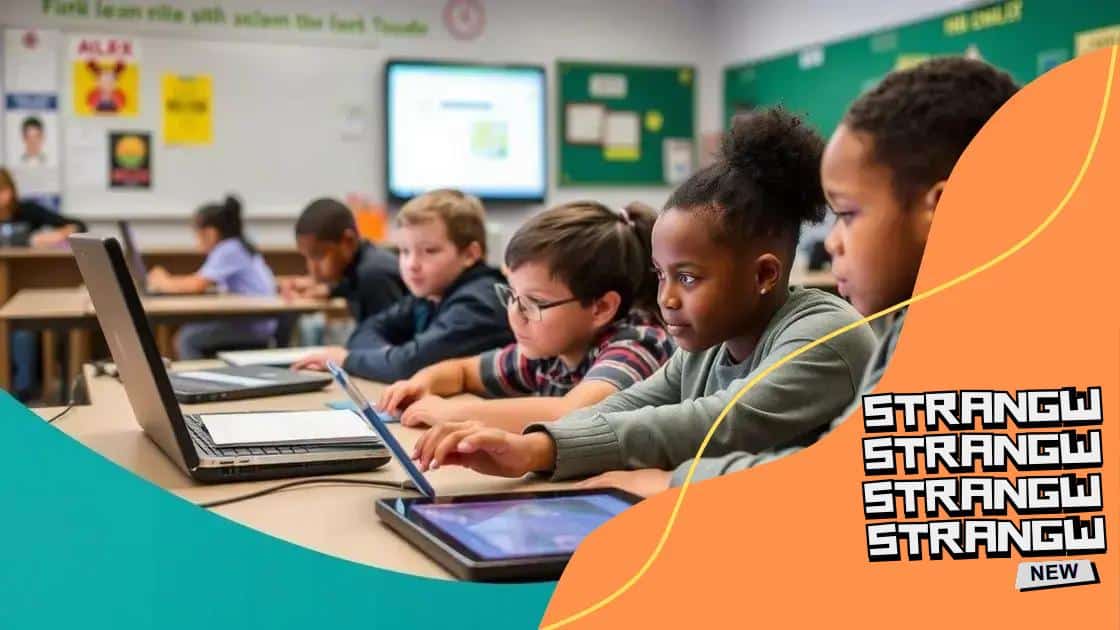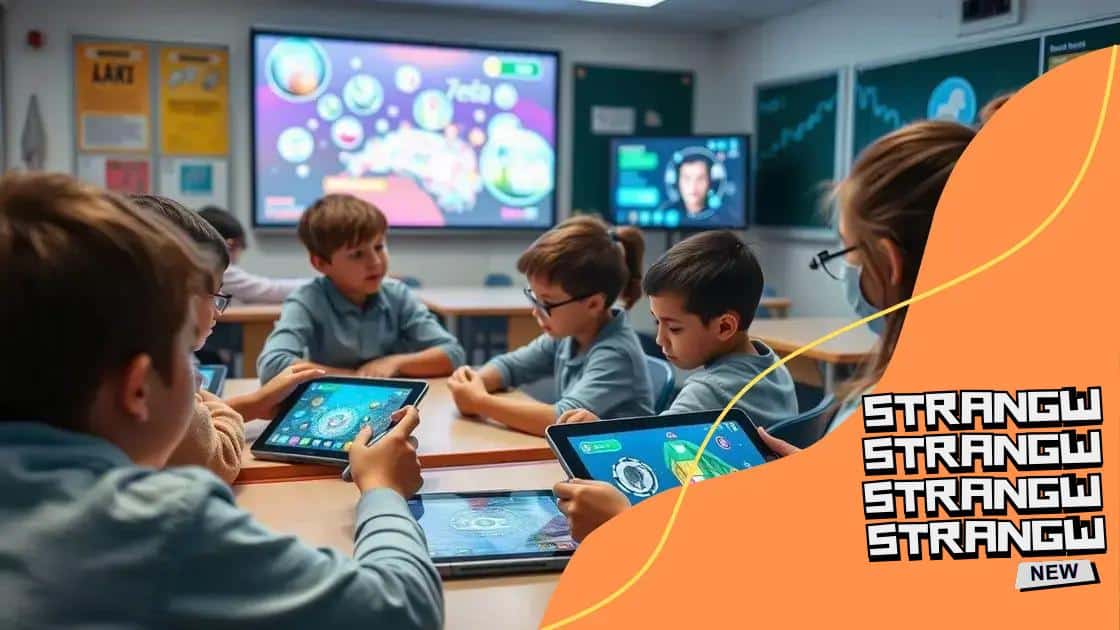AI tracking of student engagement: why it matters

AI tracking of student engagement utilizes technology to personalize learning experiences, enhance participation, and provide real-time feedback, significantly improving educational outcomes for students.
AI tracking of student engagement is transforming educational environments, enabling teachers to tailor their approaches based on real-time data. Are you curious about how this technology can enhance learning?
Understanding AI tracking of student engagement
Understanding AI tracking of student engagement is essential in today’s educational landscape. With the rise of digital learning, educators are seeking new ways to connect with their students. AI technology is at the forefront of this transformation.
What is AI tracking?
AI tracking refers to the use of artificial intelligence tools to monitor and analyze student interactions. These tools can measure how engaged students are during their lessons. By analyzing data such as time spent on tasks, participation in discussions, and response rates, teachers can gain insights to improve their teaching approaches.
Benefits of AI tracking
There are several advantages to implementing AI in education:
- Personalized learning experiences
- Real-time feedback for students and teachers
- Identification of at-risk students
- Enhanced engagement through targeted interventions
These benefits help create an environment where students can thrive. For example, if a student shows signs of disengagement, educators can intervene quickly and provide support. This proactive approach can lead to improved academic performance.
AI also helps in identifying trends related to student engagement. By analyzing patterns in data, schools can make data-driven decisions about curriculum and teaching strategies. This leads to improved outcomes for all students, as well as fostering a more engaging learning atmosphere.
Benefits of AI tracking in education
The benefits of AI tracking in education are numerous. Schools can now leverage technology to understand student behavior better. This data-driven approach helps create personalized learning experiences tailored to each student’s needs.
Enhanced Learning Experience
With AI tracking, teachers can identify which materials engage students the most. This allows them to adapt lessons accordingly. For example, if a particular video or activity captivates students, teachers can use similar approaches in the future.
Immediate Feedback
AI provides real-time insights to both students and educators. When students receive feedback quickly, they are more likely to make adjustments to their learning strategies. This instant interaction fosters a more responsive learning environment.
- Students can see their progress instantly.
- Teachers can modify lessons based on real-time data.
- Feedback increases motivation and engagement.
- Identifying areas for improvement becomes easier.
In addition to immediate feedback, AI also helps in recognizing patterns in learning. Educators can spot when a student consistently struggles with a specific concept. Early identification of these challenges enables timely interventions.
Another important aspect is the focus on student well-being. AI algorithms can analyze emotional engagement through students’ interactions. This data helps educators to ensure that students feel supported and engaged in their learning journey.
How AI improves student engagement

AI improves student engagement in many remarkable ways. By utilizing technology, educators can create a more interactive learning environment. Students are more likely to participate when they feel included and motivated.
Personalized Learning Paths
One of the key ways AI enhances engagement is through personalized learning paths. Every student learns differently, and AI can tailor lessons according to each individual’s needs. By assessing their strengths and weaknesses, AI can suggest resources that keep students interested and challenged.
Interactive Tools
AI offers interactive tools that make learning fun. These tools can include quizzes, games, and simulations that captivate students’ attention. This kind of engagement encourages students to explore topics in depth.
- Gamification of lessons
- Virtual reality experiences
- Instant feedback through quizzes
- Interactive simulations
These methods make the learning process enjoyable, reducing the boredom often associated with traditional teaching methods. When students are actively engaged, they are more likely to retain information.
Furthermore, AI can analyze student interactions to identify the elements that engage them the most. This helps educators refine their teaching strategies based on what works best for their class. For instance, if a group of students excels with visual aids, teachers can incorporate more visuals into their lessons.
AI also allows for real-time monitoring of student performance. Teachers can receive alerts when students are struggling, enabling timely intervention. This immediacy ensures that no student falls behind, maintaining a higher level of engagement throughout the learning experience.
Challenges of implementing AI tracking
The challenges of implementing AI tracking in education are significant yet manageable. Schools are often hesitant to adopt new technologies, and there are several factors contributing to this reluctance. Understanding these challenges is crucial for successful implementation.
Data Privacy Concerns
One major challenge is the issue of data privacy. Many students and parents worry about how their personal information will be used. Ensuring that data collection complies with privacy laws is essential to building trust with families.
Budget Constraints
Many educational institutions face budget limitations. Implementing AI technology can require a significant financial investment. Schools must balance their funding between technology and other essential resources.
- Initial setup costs
- Ongoing maintenance expenses
- Training educators to use new tools
- Updating technology regularly
These factors can make some schools hesitant to embrace AI solutions. Additionally, the return on investment can be unclear, which adds to the hesitation.
Another challenge is the need for proper training. Educators may feel overwhelmed by the integration of new technologies. Without adequate training, teachers might struggle to utilize AI tracking effectively. Ongoing professional development is crucial for success.
Furthermore, integrating AI into existing curriculums can be complicated. It requires collaboration among educators, IT departments, and administrators to ensure a seamless transition. Each stakeholder must understand their role in the process to achieve optimal results.
Future trends in AI and education
The future trends in AI and education promise to reshape the way students learn and teachers instruct. As technology advances, new opportunities arise to improve educational experiences for everyone involved.
Adaptive Learning Systems
One major trend is the increase in adaptive learning systems. These systems use AI algorithms to analyze student performance and adjust lessons to meet individual needs. This personalized approach ensures that each student receives the support they need to succeed.
AI-Powered Tutoring
AI-powered tutoring is becoming more common in classrooms. Virtual tutors can provide students with instant assistance on various subjects. This technology allows for personalized help outside of traditional classroom hours, making learning more accessible.
- 24/7 availability for students
- Instant answers and explanations
- Supports diverse learning styles
- Encourages independent learning
As a result, students can learn at their own pace, which can significantly enhance their understanding of the material.
Another trend is the integration of AI into administrative tasks. AI can streamline processes like grading and attendance tracking. This automation allows teachers to spend more time focusing on instruction rather than paperwork.
Moreover, the use of data analytics in education will continue to grow. Schools will analyze trends in student engagement and academic performance, allowing educators to make informed decisions about their teaching strategies. AI will help identify which methods are most effective for different groups of students.
FAQ – Frequently Asked Questions about AI in Education
How does AI tracking improve student engagement?
AI tracking helps tailor learning experiences to individual needs, making lessons more engaging and effective for each student.
What are some challenges schools face when implementing AI?
Schools often struggle with data privacy concerns, budget constraints, and the need for proper training for educators.
What future trends should educators be aware of regarding AI?
Adaptive learning systems, AI-powered tutoring, and enhanced data analytics are key trends that will shape education in the future.
Is AI technology expensive for schools to adopt?
While there are costs involved, many AI solutions are becoming more accessible, allowing schools to implement them within their budgets.





